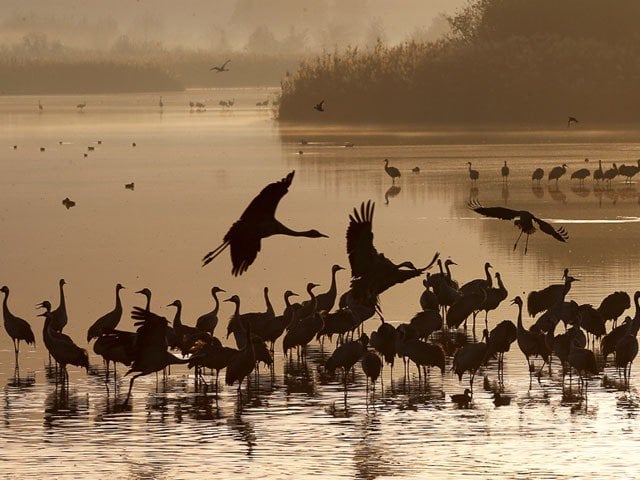Lahore: Due to lack of water in waterways, pollution and excessive hunting, a significant decrease in the number of visiting birds from Siberia to Pakistan has been recorded.
According to a survey by the Punjab Wildlife Research Institute, a 34% decline in the number of visiting fowls has been recorded in Punjab in just one year.
Every year in winter, millions of birds travel thousands of kilometers from Siberia to different regions of Pakistan, but unfortunately, the number of these visiting birds is gradually decreasing in the last few years. According to a recent survey conducted in Punjab, the number of guest birds has decreased by 33.87%.
Wildlife Research and Training Institute Gutwala Faisalabad has conducted a survey at 11 locations in Punjab this year to check the number of birds including kanjis, murgabees and other visitor birds.
According to the survey report received by The Express Tribune, 5121 birds were seen at Head Marala in 2021 and 2022, while the number decreased to 3173 in 2022 and 2023.
The number recorded at Head Kadirabad decreased from 716 to 571, at Rasool Barrage decreased from 3245 to 1801, at Kalarkharjeel from 2932 to 1894, at Ahmedabad Lake from 780 to 409, at Chashma Barrage from 30489 to 4732. , Jinnah barrage recorded a decrease from 749 to 401 and Nimal Lake recorded the highest decrease from 5079 to only 418. However, during the survey, there has been an increase in the number of these guest birds at some places. Khabeki lake has increased from 411 to 1272, Uchali lake has increased from 9995 to 22425, Jhalar lake has increased from 494 to 2297.
Wildlife Research Institute Deputy Director Dr. Misbah Sarwar told The Express Tribune that every year his department conducts a survey of various wild species found in Punjab, especially Chinkara deer, Para deer, Uryal war Nile cow. Similarly, various bird surveys are conducted, including visiting birds from Siberia. The purpose of this survey is to estimate the exact number of animals and birds and prepare recommendations for their protection, conservation and sport hunting.
Dr. Misbah Sarwar further said that in the survey conducted in the year 2021-22, the number of guest birds was estimated at 60 thousand 11 at 11 places in Punjab, while in the year 2022-23, this number has been reduced to 39 thousand 698. , the total number of visiting birds has decreased by 34%.
According to him, the reason for the decrease in the number of guest birds is the lack of water in the water bodies, increasing human interference, illegal hunting, pollution and climate change.
Punjab Wildlife allows hunting of waterfowl including pheasants, kangaroos and other waterfowl from 1st October to 31st March every year. Hunting of certain number of birds is allowed with a license fee of Rs.2000, but many hunters hunt more than the prescribed number.
On the other hand, wildlife experts say that the government has to strictly implement laws where there is a need to restore habitats of visiting birds, reduce human interference and eliminate pollution, otherwise the number of visiting birds is decreasing rapidly. It is feared that if the situation continues like this, these guest birds will disappear completely from Pakistan in the next few decades.
Dr Waseem Ahmed Khan, head of Wildlife Foundation Pakistan, disagrees with the decrease in the number of visiting birds.
Talking to The Express Tribune, he said that this year, more guest birds have come than in the past. The number of birds has increased mainly due to flooding and the formation of lakes in many areas and the rise of water levels in pre-existing water bodies.
“It is not appropriate to conclude the number of visiting birds from a single day’s survey at any location, visiting birds come in flocks and at intervals of different days,” he said. After a long journey, they stop for a few hours or a few days to rest by a lake and then move on to the next destination. Therefore, the habitats of the visiting birds have to be continuously monitored. It is possible that on the day the survey team visited, the birds were in large numbers, but the next day they flew away to their next destination.
(function(d, s, id){
var js, fjs = d.getElementsByTagName(s)[0];
if (d.getElementById(id)) {return;}
js = d.createElement(s); js.id = id;
js.src = “//connect.facebook.net/en_US/sdk.js#xfbml=1&version=v2.3&appId=770767426360150”;
fjs.parentNode.insertBefore(js, fjs);
}(document, ‘script’, ‘facebook-jssdk’));
(function(d, s, id) {
var js, fjs = d.getElementsByTagName(s)[0];
if (d.getElementById(id)) return;
js = d.createElement(s); js.id = id;
js.src = “//connect.facebook.net/en_GB/sdk.js#xfbml=1&version=v2.7”;
fjs.parentNode.insertBefore(js, fjs);
}(document, ‘script’, ‘facebook-jssdk’));



